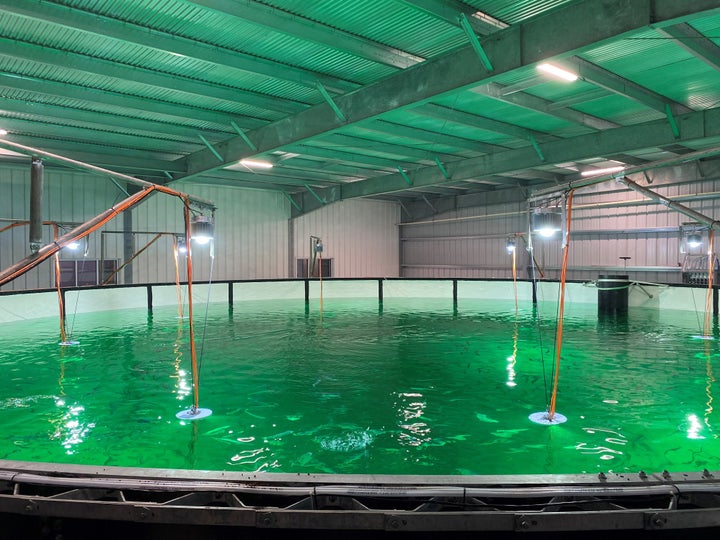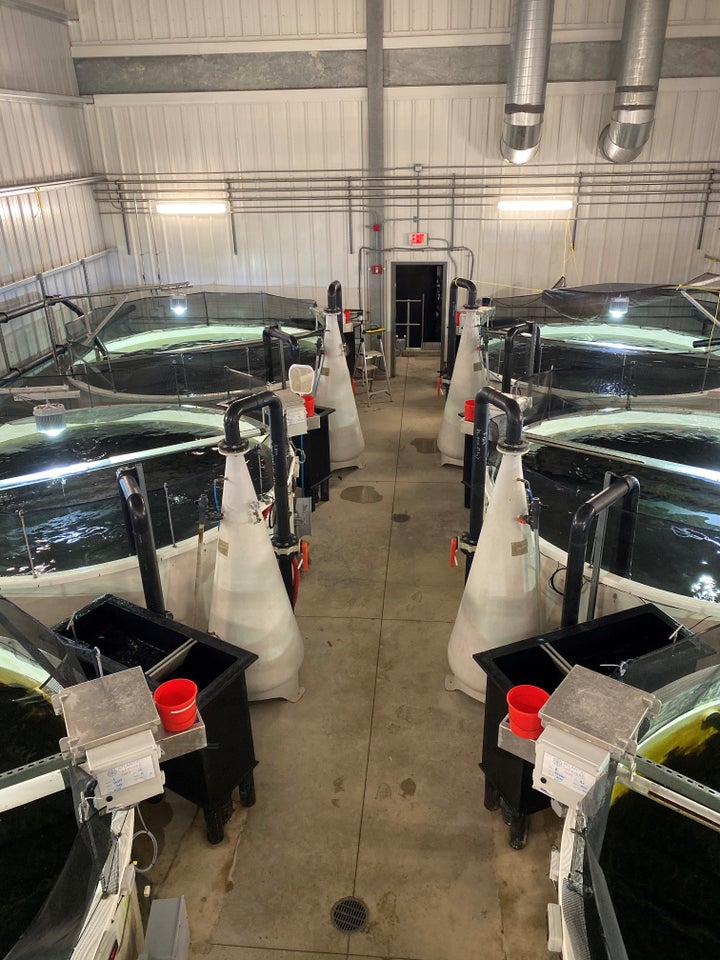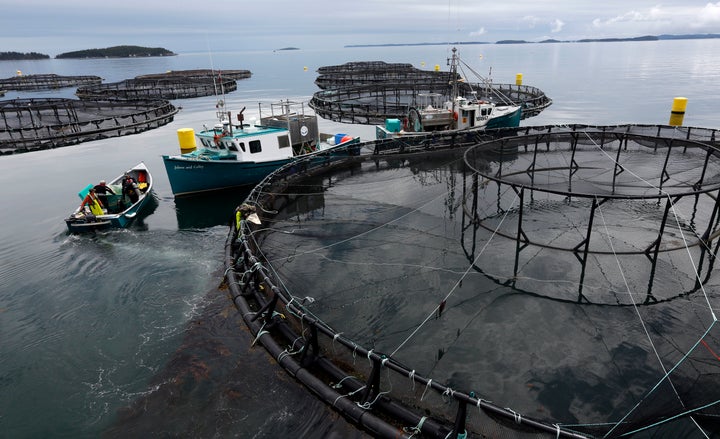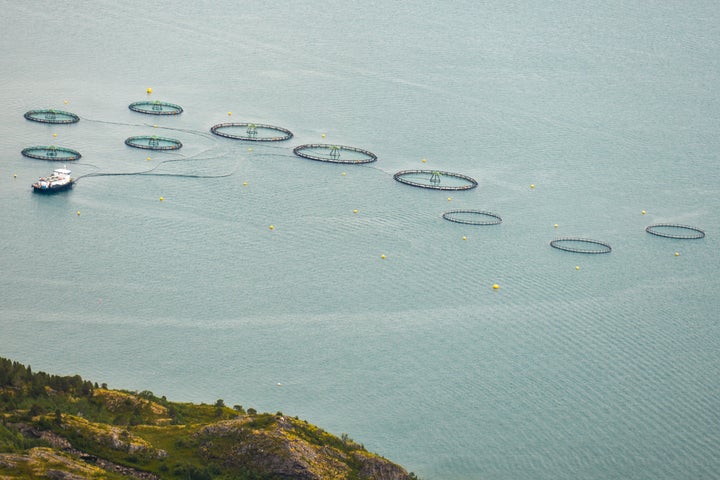Miami, with its tropical climate, might not seem the most obvious place for farming a cold-water fish. But just outside the city, in a 9-acre building ― equivalent in size to the Boston Red Sox’s home stadium ― almost 50 million salmon are projected to be grown from eggs each year.
Within this climate-controlled building, which looks like a large aircraft hangar, fish will be moved from small to large tanks of both fresh and salt water as they grow. Once they reach about 20 months, they’ll be killed and sent out to the U.S. market. The first fish are due to be harvested in May.
Atlantic Sapphire, the Norwegian company that owns this farm, says its indoor operation will be far more sustainable than traditional offshore salmon farms. It claims that within a decade, it will be able to meet half of the current U.S. demand for farmed salmon.
While we are becoming much more aware of the downsides of the intensive farming of chickens and pigs― with a constant stream of stories about their environmental impact and the overuse of antibiotics, and about animals being mistreated and forced to live in cramped conditions ― we hear far less about how our fish is produced and what effect it has on our planet.
But that’s beginning to change. There is an increasing recognition of the threats posed by fish farming, or aquaculture, including marine pollution, antibiotic overuse and significant greenhouse gas emissions. Miami’s indoor salmon megafarm is pitching itself as a solution to these problems. It’s one of a number of new land-based salmon farms around the world that are forecast to produce half a million tonnes of salmon a year within a decade ― which would be equivalent to around 20% of global salmon production today.
The owners of the Miami farm claim its land-based facility can serve as a much more sustainable source of salmon that won’t pollute the sea. But not everyone is convinced.

Salmon is incredibly popular, in part due to its credentials as a good source of protein and omega-3 fatty acids. It is the second most popular seafood in the U.S., behind shrimp, with consumption growing at 9% a year.
Most of that demand is currently met by imported salmon. The U.S. is the biggest importer of seafood in the world in dollar value terms, with farm-raised Atlantic salmon from Canada, Chile and Norway making up the majority of salmon currently consumed in the U.S.
Atlantic salmon, best suited to cold waters, were once found swimming in almost every coastal river northeast of the Hudson, but have been wiped out from these habitats largely due to historic overfishing and environmental destruction. Now, according to U.S. fisheries officials, the only native U.S. populations of the fish are found in Maine. Commercial fishing for wild Atlantic salmon is banned in the U.S. due to low population levels.
The limited availability of wild salmon means most of the salmon eaten in the U.S., and around the world, is farmed. On traditional fish farms, the fish spawn and are raised in land-based hatcheries. Once they are large enough (after six months or so), they are transferred to open water net-pens close to the shore in sheltered spots like fjords and lochs.
Farmed salmon comes with a heavy environmental cost. There have been criticisms over the use of antibiotics adding to problems of disease resistance, and farms have also been linked to the pollution of marine habitats, with untreated fish feces leading to toxic algae blooms. Escapees are a serious problem, damaging wild populations of salmon by competing with them for food, habitat and spawning partners. There’s also a cost to the fish themselves: Sea lice, tiny parasites that feed on the skin and blood of fish, are much more easily spread in high-density salmon farms.
Last year, Denmark said it would not allow any new offshore fish farms due to concerns about the marine environment being overloaded with waste, including antibiotics, and that the future of the sector would instead be on land.
The consumer advice group Seafood Watch is recommending people in the U.S. avoid a large amount of farmed Atlantic salmon currently on sale, because it is produced in ways that harm other marine life or the environment.

The salmon at the Miami megafarm will have quite a different life compared to their wild cousins and those farmed in offshore pens. They will spend almost their entire lives in tropical Florida, far from their natural home.
This is possible thanks to the emergence of land-based salmon farming technologies that allow the fish to be reared from eggs to fully grown adults in large, indoor tanks in a climate-controlled environment. All the water needed for the farm will come from a deep-lying saltwater aquifer that could not be used for human consumption.
Atlantic Sapphire says its land-based farmed salmon facility will prevent any damage to fragile marine areas, and will mitigate the risk of escapees since its fish will spend their whole lives indoors.
They also won’t use any antibiotics, because, they say, they simply won’t need to. “[With offshore net pens] the salmon are exposed to whatever comes their way, including viruses and algae,” Atlantic Sapphire founder Johan Andreassen told HuffPost. “We don’t have any of those problems.”
Farmed fish, whether land- or marine-based, generally also compares quite well to other foods for greenhouse gas emissions, deforestation and habitat destruction, says Dr. Rebecca Gentry, an aquaculture specialist from Florida State University.
One of the biggest environmental issues for salmon, she says, is the air transport needed to bring it from countries like Chile and Norway into the U.S.
Atlantic Sapphire says this is the big advantage for them. “The locations of pens in cooler waters are far away from customers,” Andreassen said. “Being in Miami means we can collapse the food miles of getting the fish to market.”
The company plans to transport all its fish by road. And Ryan Bigelow, Seafood Watch’s senior program manager, believes the company will have a sales advantage by labeling the product as being from the United States.

It seems like a win-win ― onshore salmon farms like Atlantic Sapphire’s can reduce wild escapees, marine pollution and sea lice. But, Gentry says, it still has one major drawback: energy use.
Recirculating aquaculture systems ― the kind used to rear the salmon in Miami ― require high amounts of energy to cool the water for the fish. This increases both operational costs and the potential impacts created by the use of fossil fuels. The company says it is exploring the use of renewables in the future.
High energy and running costs have also contributed to a number of high-profile failures of onshore fish farms in the U.S. Although land-based salmon farms, or RASes, are on Seafood Watch’s recommended list for consumers, Bigelow says they haven’t considered the environmental cost of energy use in that assessment.
The higher energy costs mean higher prices for the customer. And Andreassen acknowledges that the salmon produced in Miami will initially be more expensive than imported alternatives. But the company expects consumers to be willing to pay a premium for what they believe will be a more sustainably-produced farmed salmon.
“Despite us having a production cost disadvantage due to the energy needed, this only tells half the story,” a spokesperson for Atlantic Sapphire told HuffPost. “It is important to take into account the large logistics costs and CO2 emissions of flying salmon on airplanes from the [overseas] producing regions to the end-market.”

The Global Salmon Initiative, an industry-backed initiative to improve sustainability standards, said in a statement to HuffPost that it expects marine-based aquaculture to continue to be the main producer of salmon.
Others agree, noting the potential to improve marine-based fish farms. The Nature Conservancy said moving salmon farming further offshore and away from the coastal environment is just as much a solution for sustainable aquaculture as land-based systems are.
“Just because a farm is a RAS design does not guarantee its sustainability,” said Robert Jones, the organization’s global aquaculture lead. “The environmental impact of each specific operation must be carefully evaluated ― the environmental characteristics of the farming site, the source of water utilized, and what’s being done with the discharged water and solids.”
While the salmon industry debates whether its future will be land-based or coastal, there’s another big issue still to be grappled with: the ethics of fish farming. How do consumers feel about salmon being raised indoors and away from their natural environment, rather than in netted pens offshore?
“I don’t know if the fish will be happier in a land-based tank or coastal pens,” Gentry said. “Some of it might depend on stocking density, but the priority should be for healthy fish to maintain fish quality and your own market and consumers.”
Andreassen said that while any form of fish farming ― whether in coastal pens or indoor tanks ― is taking salmon out of their natural environment, he’s confident indoor operations can achieve higher standards of animal welfare. “For me, the key is whether the fish is healthy and grows. We’re trying to create the ideal conditions for salmon.”
Seafood Watch’s Bigelow said he’s unsure how consumers and the industry will react to and manage the issue of fish farm welfare. “It is going to be a very hot topic over the next decade,” he said. “The whole sustainable seafood industry is talking about it at the moment. We’re not quite there yet as a society and industry when it comes to fish. Other animals are easier to feel compassion and feelings for.”
For now, Atlantic Sapphire has a bigger job on its hands: convincing U.S. consumers to pay a premium for its salmon. While Andreassen sees land-based farming as the future for feeding the planet, Gentry says it’s too soon to write off marine-based salmon farming.
“It is great to be trying to produce food in a more sustainable way, but often there is a trade-off in terms of the cost of the product,” she said. “So is this salmon going to feed the world or be a premium product?”
For more content and to be part of the “This New World” community, follow our Facebook page.
HuffPost’s “This New World” series is funded by Partners for a New Economy and the Kendeda Fund. All content is editorially independent, with no influence or input from the foundations. If you have an idea or tip for the editorial series, send an email to thisnewworld@huffpost.com.
